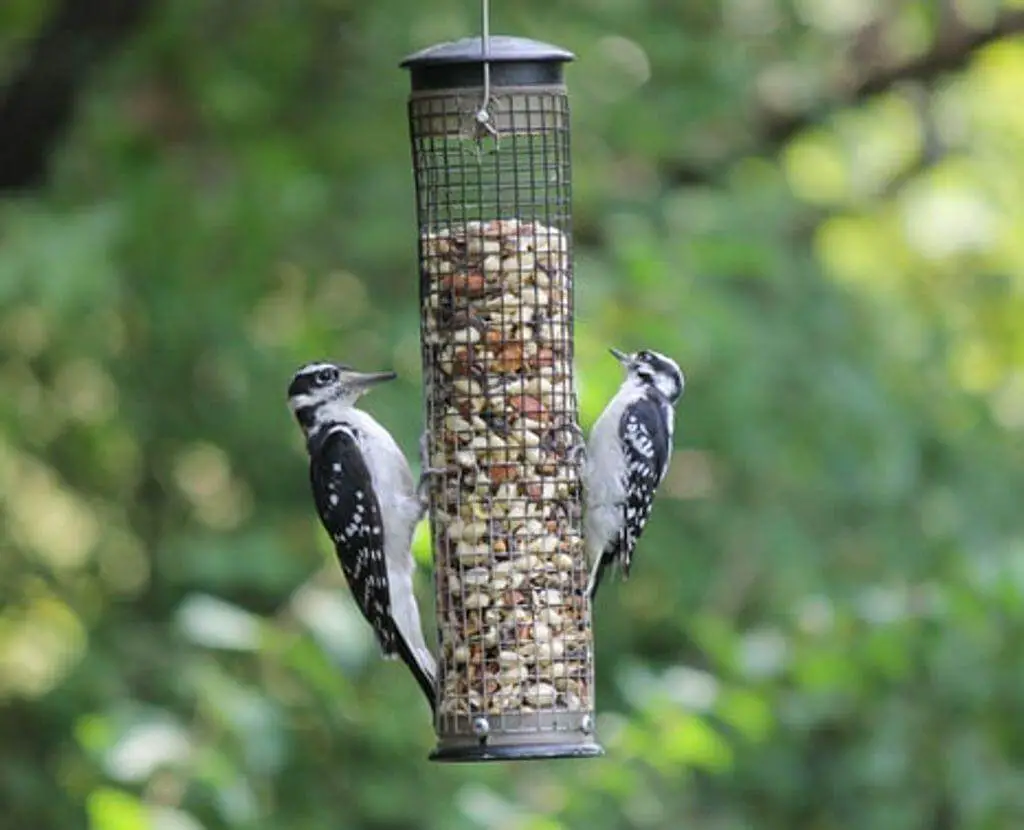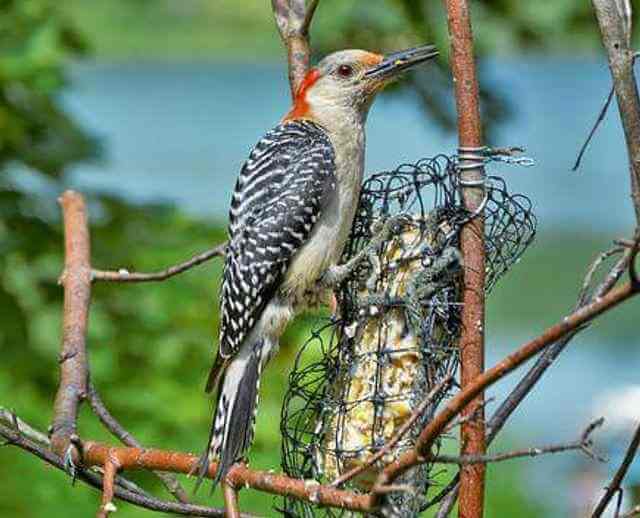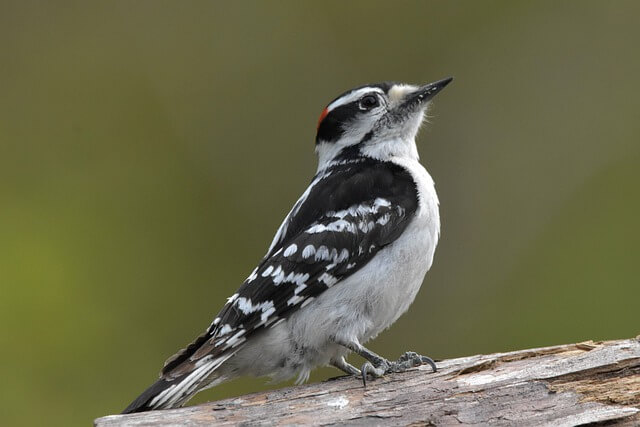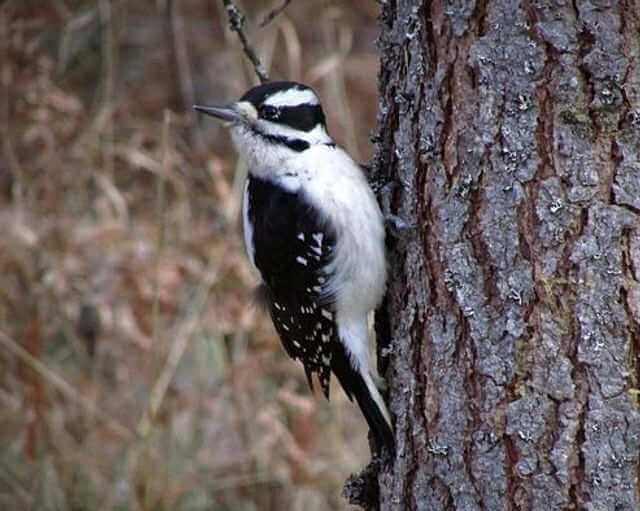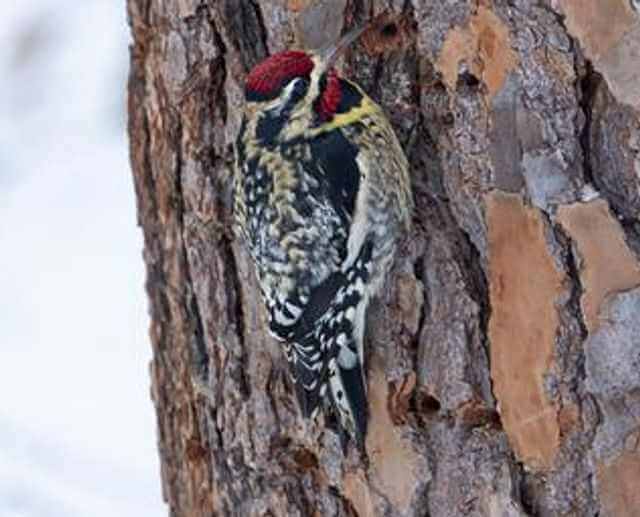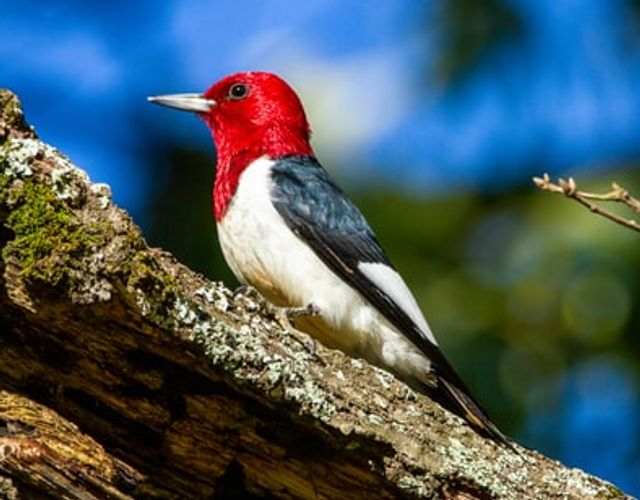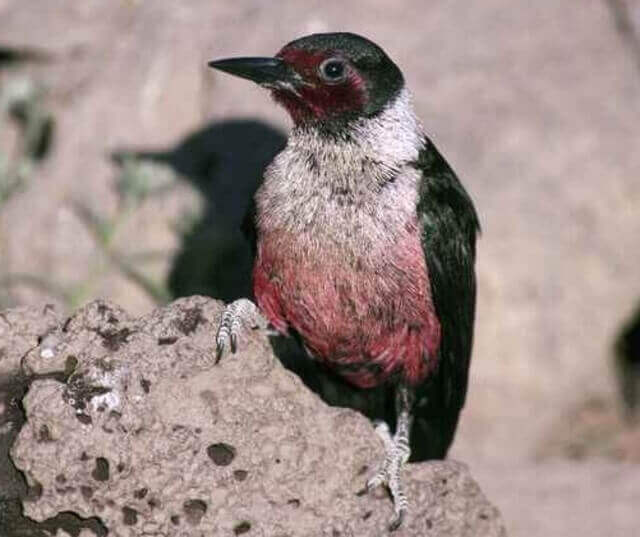Virginia is home to a diverse array of woodpeckers, and spotting them can be an exciting challenge. In 2025, we’ve put together the ultimate ID guide to help you identify the 8 most common woodpecker species in the state. From the striking Red-bellied Woodpecker to the elusive Pileated Woodpecker, this guide will give you the tools you need to recognize these fascinating birds in the wild. Let’s dive into the unique features and habits of Virginia’s woodpeckers!
Table of Contents
Types of Woodpeckers in Virginia
Red-bellied Woodpecker
- Length: 9.5 in (24 cm)
- Weight: 2.0-3.2 oz. (56-90 g)
- Wingspan: 13.0-16.5 in (33-42 cm)
- Scientific Name: Melanerpes carolinus
- Frequency of Occurrence: 38.31% (Statistic by: eBird)
- Where To Find Them: The Red-bellied Woodpecker is a common bird found in many parts of Virginia. They can be found in the eastern and central parts of the state, as well as the Piedmont region. These woodpeckers are generally found in wooded areas, but can also be seen in yards and parks.
- How to Attract: Red-bellied woodpeckers will eat a variety of foods, including insects, nuts, and seeds. You can provide a food source by planting trees and shrubs that produce nuts and berries, or by setting out feeders that offer bird seed or suet. Second, create a place for the birds to perch. Red-bellied woodpeckers like to perch on large branches or tree trunks.
Description: The red-bellied woodpecker is a medium-sized woodpecker that ranges from the eastern United States to parts of Central America. They inhabit deciduous forests and mixed forests, as well as parks and gardens in urban areas. These birds forage for insects on tree trunks and branches. their diet consists mainly of insects, but they also eat fruit, nuts, and seeds.
Red-bellied woodpeckers build nests in cavities in dead trees or in artificial nesting boxes. The female lays 3 to 5 eggs, which are incubated by both parents for about two weeks. The young birds fledge about two months after hatching.
Related Post: How to Attract Red-bellied Woodpeckers to your Yard?
Downy Woodpecker
- Length: 5.5-6.7 in (14-17 cm)
- Weight: 0.7-1.0 oz. (21-28 g)
- Wingspan: 9.8-11.8 in (25-30 cm)
- Scientific Name: Picoides pubescens
- Frequency of Occurrence: 32.87%
- Where To Find Them: They can be found in every part of the state, but they are most common in the eastern and western parts of Virginia.
- How to Attract: Downy Woodpeckers eat insects, so try to provide a variety of insects in your yard. You can do this by planting insect-rich plants, or by adding a feeder that offers insects such as suet or mealworms. Second, create a nesting site for the birds. Downy Woodpeckers prefer dead trees or tree stumps for nesting, but they will also use nest boxes if they are available.
Description: The Downy Woodpecker (Picoides pubescens) is a small woodpecker that ranges throughout much of North America. This species prefers habitats with mature trees, where they can find insects to eat on the bark and crevices of the tree.
Downy Woodpeckers also eat berries and seeds, and sometimes they will raid bird feeders for food. These birds build their nests in tree cavities, or sometimes in birdhouses if they are available. Downy Woodpeckers typically have two eggs, which both parents help to incubate and care for.
Related Post: How to Attract Downy Woodpeckers to Your Yard? (Easy!)
Northern Flicker
- Length: 11.0-12.0 in (28-31 cm)
- Weight: 3.9-5.6 oz. (110-160 g)
- Wingspan: 16.5-20.0 in (42-51 cm)
- Scientific Name: Colaptes auratus
- Frequency of Occurrence: 17.96%
- Where To Find Them: They can be found in the eastern and central parts of the state, as well as in the Shenandoah Valley. Northern Flickers prefer open areas with trees and brush, but they can also be found in forested areas.
- How To Attract: First, provide a source of water. Flickers love to bathe and will visit bird baths and fountains regularly. Second, plant trees and shrubs that produce berries and seeds. Flickers love to feast on insects, but they also enjoy a good meal of fruit or seeds. Third, offer them a place to perch. A platform feeder or a simple pole with some horizontal branches will do the trick. If you follow these tips, you should be able to enjoy the company of Northern Flickers in your backyard!
Description: The Northern Flicker is a medium-size woodpecker found primarily in North America, Europe, and East Asia. They are common in open woodlands, parks and gardens. Northern Flickers have a range of about 6,000 miles and live in a variety of habitats including coniferous forests, deciduous woods, riparian areas, open fields and even urban areas.
They forage on the ground for insects and other small creatures. They also eat fruits and nuts. Northern Flickers build their nests in cavities in trees or buildings.
Related Post: How to Attract Northern Flickers to your Backyard (Easy)
Pileated Woodpecker
- Length: 15.8-19.3 in (40-49 cm)
- Weight: 8.8-12.3 oz. (250-350 g)
- Wingspan: 26.0-29.5 in (66-75 cm)
- Scientific Name: Dryocopus pileatus
- Frequency of Occurrence: 15.47%
- Where To Find Them: Some of the most common locations where they can be found include Shenandoah National Park, George Washington National Forest, and the Allegheny Mountains.
- How To Attract: You can provide a food source for pileated woodpeckers by putting out a feeder that has suet or seeds in it. Pileated woodpeckers also like to eat insects, so you can put out a bug tray or hang a piece of fruit from a tree in your yard to attract them. You can also provide a place for pileated woodpeckers to live by putting up a nest box. They will use the box to nest in during the spring and summer months.
Description: Pileated Woodpeckers are the second-largest woodpecker in North America, measuring 16-19.5″ inches in length and weighing up to 12 ounces. They are a common sight throughout eastern forests, where they range from southern Canada to Florida and west to Texas. Pileated Woodpeckers inhabit a variety of habitats, including deciduous forests, coniferous forests, riparian corridors, and even urban areas.
They forage primarily on the ground for insects, but will also climb trees in search of food. Pileated Woodpeckers nest in cavities excavated in dead trees or logs. The female lays 4-6 eggs, which are incubated by both parents for 12-14 days. Young stay with the parents for about 5 weeks after hatching.
Related Post: How to Attract Pileated Woodpeckers to your Yard (Fast)
Hairy Woodpecker
- Length: 7.1-10.2 in (18-26 cm)
- Weight: 1.4-3.4 oz. (40-95 g)
- Wingspan: 13.0-16.1 in (33-41 cm)
- Scientific Name: Picoides villosus
- Frequency of Occurrence: 7.66%
- Where To Find Them: The parts of Virginia where they are most common include the eastern Blue Ridge Mountains, the Shenandoah Valley, and the Piedmont region.
- How To Attract: Hairy Woodpeckers like to eat insects, so you can put out a feeder that has insect-rich food or plant some insect-eating plants in your yard. Another thing you can do is provide them with a place to perch. You can do this by putting up a birdhouse or by planting some trees or shrubs that they will like to perch on. Finally, you can make sure your yard is free of predators.
Description: The Hairy Woodpecker is a medium-sized woodpecker that ranges across most of North America. They prefer open woodlands, parks, and gardens, and can be found in both rural and urban areas.
These birds feed primarily on insects, but will also eat fruit, seeds, and nuts. Hairy Woodpeckers nest in tree cavities, either natural or excavated by the birds themselves. They typically lay 4–5 eggs, and both parents help to incubate and care for the young.
Yellow-bellied Sapsucker
- Length: 7.1-8.7 in (18-22 cm)
- Weight: 1.5-1.9 oz. (43-55 g)
- Wingspan: 13.4-15.8 in (34-40 cm)
- Frequency of Occurrence: 5.39%
- Where To Find Them: They are most common in the parts of the state that are located in the eastern and southeastern areas. Some of the specific locations where they can be found include the Shenandoah Valley, the Blue Ridge Mountains, and the James River Valley.
- How to Attract: They are attracted to areas with a lot of trees and are known to drill holes in trees in order to extract sap. Here are a few tips on how to attract these birds to your yard: Plant a variety of trees and shrubs. The sapsucker is attracted to maple, birch, and oak trees, as well as juniper and cedar bushes. Leave some dead trees standing. These provide the perfect habitat for the sapsucker and also attract other types of birds. Install a bird feeder. This will give the sapsuckers a place to eat when they’re not drilling holes in trees. Keep your yard clean.
Description: The yellow-bellied sapsucker is a medium-sized woodpecker that ranges throughout most of North America. They prefer deciduous forests and can be found in both rural and urban areas. These birds feed primarily on insects, but also eat fruit and sap from trees.
Yellow-bellied sapsuckers nest in holes in trees, often near water. The female lays 3-7 eggs, which the male incubates for about two weeks. The young birds stay with the parents for several months after hatching.
Related Post: 16 Interesting Sapsucker Facts Revealed!
Red-headed Woodpecker
- Length: 7.5-9.1 in (19-23 cm)
- Weight: 2.0-3.2 oz. (56-91 g)
- Wingspan: 16.5 in (42 cm)
- Scientific Name: Melanerpes erythrocephalus
- Frequency of Occurrence: 3.41%
- Where To Find Them: They can be found in parts of the state where there are large trees, including the eastern and western mountains, the Shenandoah Valley, and the Piedmont. These woodpeckers prefer to live in mature forests, but they can also be found in open areas with scattered trees.
- How to Attract: First, make sure you have a few large trees in your yard. These birds like to nest in dead trees or those that are dying. You can also provide them with a bird feeder that has insect-friendly food. Finally, keep your yard free of harmful chemicals and pesticides. These birds are very sensitive to environmental toxins and can be killed by them.
Description: The Red-headed Woodpecker is a medium-sized woodpecker that ranges from the eastern United States to parts of Mexico. These birds primarily inhabit deciduous forests, but can also be found in parks, orchards and residential areas. They forage on the ground for insects, as well as in trees for larvae, sap and fruit.
Red-headed Woodpeckers build their nests in cavities in trees, sometimes using abandoned nests of other birds. The female typically lays 3-5 eggs, which are incubated by both parents for about two weeks. The chicks are fledged at around 10 weeks old.
Related Post: Interesting Red-Headed Woodpecker Facts (Explained)
Red-cockaded Woodpecker
- Length: 7.9-9.1 in (20-23 cm)
- Weight: 1.5-1.8 oz. (42-52 g)
- Wingspan: 14.2 in (36 cm)
- Scientific Name: Picoides borealis
- Frequency of Occurrence: 0.0471%
- Where To Find Them: The bird is most common in the eastern and southeastern parts of the state, and can also be found in the Blue Ridge Mountains. The red-cockaded woodpecker prefers to live in pine forests, and often makes its home in old-growth trees.
- How to Attract: You can do this by putting out a feeder filled with suet or peanuts. Another thing you can do is provide a water source for the bird. You can do this by putting out a bird bath.
Description: The red-cockaded woodpecker is a federally endangered species that lives in the southeastern United States. They are found in mature pine forests and their range extends from Texas to Florida. These birds live in cavities that they excavate in dead pine trees. They also use abandoned woodpecker nests or natural tree hollows.
The diet of red-cockaded woodpeckers consists mostly of insects, which they capture by pecking tree bark. They also eat nuts, berries, and sap. These woodpeckers breed from April to June. The female lays 3-4 eggs in a cavity and both parents help incubate them for about 14 days.
Lewis’s Woodpecker
- Length: 10.2-11.0 in (26-28 cm)
- Weight: 3.1-4.9 oz. (88-138 g)
- Wingspan: 19.3-20.5 in (49-52 cm)
- Scientific Name: Melanerpes lewis
- Frequency of Occurrence: 0.0009%
- Where To Find Them: In Virginia, Lewis’s Woodpeckers are most common in the eastern and central parts of the state. They can also be found in some areas along the Blue Ridge Mountains. Locations where they are most commonly seen include Shenandoah National Park and the James River Valley.
- How to Attract: First, try planting some trees and shrubs that they like to feed from, such as maples, birches, and sumacs. You can also provide them with a source of water by installing a birdbath or pond. Finally, make sure you have plenty of dead trees or logs for them to nest in. If you follow these tips, you should be able to get these beautiful birds visiting your yard soon!
Description: Lewis’s Woodpecker (Melanerpes lewis) is a medium-sized woodpecker that ranges from southern British Columbia in Canada to Baja California in Mexico. This species inhabits open woodlands, parks, and gardens. Lewis’s Woodpeckers forage on the trunks and branches of trees and shrubs, dieting on insects and spiders.
They nest in tree cavities, excavating their own nests or using natural cavities or abandoned woodpecker holes. Up to four eggs are laid and incubated by both parents for about two weeks. Young fledge at around two months old.
Conclusion
In conclusion, Virginia offers a diverse range of woodpeckers for bird enthusiasts and nature lovers to observe and identify. With the help of the Ultimate ID Guide for 2023, one can easily spot and learn about the eight unique species of woodpeckers found in Virginia.
Whether it’s the vibrant red-headed woodpecker or the elusive and rare ivory-billed woodpecker, Virginia’s forests and woodlands are home to a variety of these fascinating birds, making it a prime destination for birdwatching enthusiasts.
Related Post: 29 Most Common Birds of Virginia – (Photos, ID & Stats)

